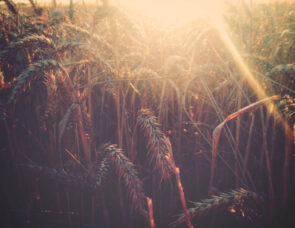Our Christian harvest festival has its biblical roots in the Feast of Tabernacles. Here are some group activity and craft ideas to create a special prayer space linked to the celebration.

On your marks
In Leviticus 23:42, there is the instruction to the people of God to live in shelters for seven days. The Feast of Tabernacles (sukkot) is an autumn harvest festival that reminded the people of Israel of their 40 years wandering in the desert. It is a time of rejoicing, sleeping under the stars and being hospitable. The following idea is an outline for creating ‘a group shelter’, which you could decorate and make a special ‘den’ for thanksgiving prayer in the place you normally meet.
Get set
A Jewish tabernacle or booth (sukkah) is normally made outdoors ‘under the stars’. It should be big enough to stand up and move around in. What follows is an idea for an indoor version. This could be done as a group activity offering the opportunity to talk as a group about giving thanks to God as you work together, finishing with a time of quiet prayer together inside the finished ‘home’.
You will need:
- two or more clothes horses and some bamboo poles
- old sheets or curtains
- greenery, including fruit and vegetables – or if real foliage isn’t available, paper chains and streamers from green paper
- mats and cushions for the floor
- some sweet, possibly sugared almonds
- green canes, green card, white and pink tissue paper
- oranges, cloves, green narrow ribbon – optional to make a pomander
- tea lights.
Bible link: Deuteronomy 16:13-15, where Moses gives instructions about celebrating the Festival of Tabernacles (or Shelters).
Go!
- Stand up the clothes horses close together as a frame for the shelter and then tie them firmly together using bamboo poles across the top to make a roof.
- Hang old sheets or curtains over the frame for walls.
- Decorate your shelter with as much greenery as you can.
- Place mats and cushions on the floor.
- Set about decorating your ‘harvest home’ as if you were going to live there for a few days – for example, you could paint pictures of different things God has made – the heavens, the sky, the sea, mountains, people, animals, birds, fish, water and light.
- During the celebrations of the Feast of Tabernacles, a bundle of plants (a lulav) – including a palm leaf, a willow branch and a myrtle shoot – would be tied together, held in the right hand and waved about in all directions as psalms of praise were recited. Worshippers also held a piece of citrus fruit in the left hand (an etrog),which represented the heart. As part of your thanksgiving praise in your ‘harvest home’, wave a lulav as you use the words of Psalm 9:1-2, and remind each other of the wonderful things God has done in your lives and in the world. (A lulav can be made from green canes, green card, and white and pink tissue paper.)
- Your shelter should also smell sweet. Why not make a pomander to hang inside? You will need a small orange, several cloves (which are stuck into the orange) and some narrow green ribbon (to tie around the pomander and hang it up). It will probably be easier to stick the cloves in the orange if you make holes with a cocktail stick first.
- On one of the days of the Feast of Tabernacles, lamps were lit in each corner of the temple, and each lamp had four flames. Under supervision, light some tea lights in the corners of your shelter and use this as a focus for Jesus who was described, among other things, as ‘the light of the world’.
- On the last day of the festival, water was fetched and poured over the altar in the temple and the people prayed for rain. In your shelter, pray for those who need rain and clean water at this time.
- During the Feast of Tabernacles, traditional recipes included fruit and nuts. Sugared almonds are traditionally special gifts on such celebrations. Enjoy a special feast of thanksgiving inside your very own ‘harvest home’.
These ideas are adapted from Step into the Story by Margaret Spivey and Anna Jean, which was first published in 2003. It is no longer in print.

 Download
Download